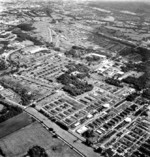ROF Chorley
| Type | 199 Factory | |
| Historical Name of Location | Euxton, England, United Kingdom | |
| Coordinates | 53.680000000, -2.661000000 |
Contributor: Alan Chanter
ww2dbaseThe government-owned, munitions filling factory, Royal Ordnance Factory, Chorley, was one of the largest factories in England, United Kingdom during the Second World War. Located in Euxton, near Chorley, Lancashire, the factory was designed and built to encompass the whole range of explosive filling activities including the manufacture and development of explosive weaponry and other devices. It would, in particular, supply Allied armies with vast quantities of 25-pounder ammunition and howitzer shells. The decision to build at Chorley in Lancashire was made in the summer of 1935 as a part of the government's rearmament programme. Building on the 928-acre site, which had been selected specifically to disperse ammunition and munitions production away from major cities and the south-east of England, began in 1937, and the quantity of materials involved was truly staggering; 30 million bricks, 1 million cubic yards of concrete, 15,000 steel window frames, twenty-five miles of railway and 1,500 buildings. The work involved building the world's largest concrete mixer, which turned out 5,000 tons of concrete a day, moved by thirty trains and 300 lorries on site. From the air the Chorley site looked like a cratered lunar landscape since it consisted of a complex of many small workshops, each surrounded by 25-foot high earthworks and reinforced concrete walls to contain blast in the case of accident. The site also contained extensive underground magazines, comprehensive lightning protection and individual buildings linked by paths, roads and railways, surrounded by a guarded 9-mile perimeter fence.
ww2dbaseROF Chorley was split into two areas by the railway and connected by a road bridge. The smaller area was the administration site which contained the factory's main administration office, test laboratories, a medical centre, the MOD Police and a large canteen that was also used as an entertainment venue. The larger area, north of the railway was the main explosive, or ammunition filling, site. ROF Chorley had its own private railway station, ROF Halt, separated from the factory by brick boundary walls some 20 foot high along each side. The factory was designed to be completely self-sufficient. It had its own water supply and electricity generators, medical centre with a mortuary beneath, fire brigade with two full-time appliances, police station and internal bus service. Communal washrooms for male and female workers were also provided where they could wash off any chemicals they may have come into contact with during their daily work.
ww2dbaseLimited production began at the end of 1938 – the first shell to be filled was a 3.7-inch anti-aircraft round in December - and the factory was officially opened by the king in the spring of 1939. The builder threw a gigantic party for the 12,000 building workers which was attended by the popular singer, Gracie Fields. 35,000 people were to work at ROF Chorley, which in one week, in 1942, took in 500 tons of TNT, 250 tons of ammonium nitrate and 250 tons of cordite, and delivered, among other things, 210 truckloads of 25-pounder ammunition and seventy trucks of 5.5-inch howitzer shells. One of the more interesting projects undertaken at Chorley during the war was the building of Barnes Wallis' bouncing bombs that were used in the famous Dambusters raid in 1943.
ww2dbaseAfter the war the decline in demand for munitions resulted in much of the factory turned over to the production of concrete components for pre-fabricated houses, concrete railway sleepers for the newly nationalised British Railways, and manufactured clothing. In the 1980s it became part of the privatised Royal Ordnance PLC and later as a production unit of BAE Systems Global Combat Systems Munitions. ROF Chorley closed in 2005-07; the majority of the site being decontaminated and demolished; the land being sold off for housing in the new Buckshaw Village.
ww2dbaseSources:
Professor David Edgerton: Britain's War Machine (Penguin Books 2011)
Wikipedia: ROF Chorley
Facebook Groups: ROF Chorley (Buckshaw village)
Last Major Update: Oct 2018
ROF Chorley Interactive Map
Photographs
 |
Please consider supporting us on Patreon. Even $1 per month will go a long way! Thank you. Please help us spread the word: Stay updated with WW2DB: |
Visitor Submitted Comments
23 Apr 2021 01:37:08 PM
My mother in law worked at the munition factory around 1940 /41
3 May 2021 02:46:43 PM
My grandmother, Elizabeth Belshaw worked there, but I'd like to know how would she have done the daily commute from Ashton in Makerfield.
A challenging task for a non-car owner even with todays public transport.
13 Oct 2022 01:48:54 PM
My mum Ethel Martin and her mum Alice Martin travelled from Farnworth, Nr. Bolton to work there. My mum said she drove bombs on a dilly?
28 Mar 2023 02:57:53 PM
Elizabeth Belshaw would have had to get to Wigan NW station to catch the 06:33 special train direct into ROF Halt inside the factory and be returned to Wigan NW at 17:15.
All visitor submitted comments are opinions of those making the submissions and do not reflect views of WW2DB.

Euxton, England, United Kingdom
Latitude-Longitude:
53.6800, -2.6610
- » 1,182 biographies
- » 337 events
- » 45,119 timeline entries
- » 1,248 ships
- » 350 aircraft models
- » 207 vehicle models
- » 376 weapon models
- » 123 historical documents
- » 261 facilities
- » 470 book reviews
- » 28,410 photos
- » 365 maps
Winston Churchill
Please consider supporting us on Patreon. Even $1 a month will go a long way. Thank you!
Or, please support us by purchasing some WW2DB merchandise at TeeSpring, Thank you!
21 May 2020 04:06:44 AM
My Mother work in it 1940 her name was Mrs. Agnes Harrison